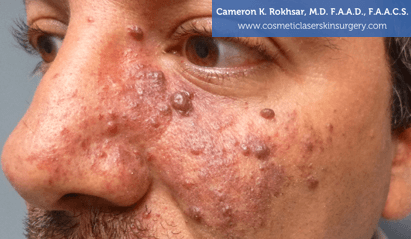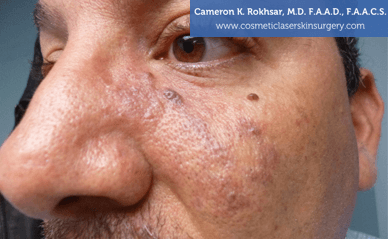Port Wine Stains Laser Treatment in New York
Remove Port Wine Stains in New York
Port-wine stains (nevus flammeus) are malformations of tiny blood vessels that connect the veins to the arteries (capillaries) located in the upper levels of the skin. These irregularly shaped patches range in color from light pink to red to dark red-violet and may darken with age. Port-wine stains, usually located on the neck, face, and scalp, occur in about 0.5% of newborns.
More than one-third of infants are born with a pink patch at the nape of the neck or on the eyelids (called an “angel’s kiss,” “salmon patch,” or “stork bite”). These are minor blood vessel dilations and are not true port-wine stains. Those located on the eyelids and forehead fade slowly and eventually disappear. Those at the base of the neck are often permanent. For help with getting rid of port wine stains, contact Dr. Rokhsar to schedule an appointment.
Port Wine Stains Laser Treatment Before and After


* Results May Vary.
Causes
The lesions are congenital, but the cause is unknown.
Signs and Symptoms
Port-wine stains are present at birth and vary in size and shape. They first appear pale pink in color and darken with time. The texture can change gradually from smooth to thickened and pebbled.
Diagnosis
Port-wine stains are diagnosed mainly by their appearance.
Infants with a port-wine stain that involves the upper and lower eyelids usually undergo a magnetic resonance imaging (MRI) scan or other types of brain scans. This can help the physician diagnose or exclude Sturge-Weber syndrome. Approximately 5% of infants with a port-wine stain on the eyelids are at risk for this condition, in which the lesion involves the trigeminal nerve, the eye, the meninges (thin membranes surrounding the brain), and the brain. Seizures occur in about 80% of those afflicted. Glaucoma, developmental delays, and partial paralysis are other aspects of Sturge-Weber syndrome.
Treatment for Getting Rid of Port Wine Stains
Pulsed-dye laser treatments offer safe and effective treatment for port-wine stains. Treatment success depends on the age at which it is begun and the location of the lesion. With multiple treatments, most port-wine stains can be significantly lightened. Topical, local, or general anesthesia can be administered before the procedure to minimize discomfort.
Non-Surgical Skin Tightening FAQ
What are port wine stains?
Port wine stain is a type of birthmark that appears as a flat, pink, red, or purple patch on the skin. These birthmarks are caused by a capillary malformation in the skin, which means that there is an abnormality in the blood vessels that causes them to expand in size and turn the skin red. Port wine stains typically appear at birth and persist throughout life. Some grow with age and develop thick plaques.
While port wine stains are generally harmless, they can be associated with certain syndromes involving the blood vessels. If a port wine stain is located on the eyelid or forehead, it may require treatment to prevent vision or neurological problems. In most cases, laser treatments can help fade the birthmarks.
Port wine stains have nothing to do with a woman’s health or actions during pregnancy. They are the result of a mutation in a specific gene that causes the abnormal blood vessel growth. If you or your child has a port wine stain, we recommend consulting with Dr. Cameron Rokhsar, who is a double-board-certified dermatologist and dermatologic surgeon, and fellowship trained in laser surgery. who can assess the mark and provide appropriate treatment options with lasers based on individual circumstances.
What causes port wine stains?
Port wine stains are birthmarks that result from abnormally formed capillaries, which are tiny blood vessels located under the skin. These capillaries dilate, which means they’re more open or stretched out than normal. This dilation allows more blood to flow through the capillaries, resulting in the distinctive red or purple color of the birthmark. The exact cause of the abnormal capillary formation is not yet fully understood by scientists, but it is believed to be a genetic mutation that occurs in utero.
While port wine stains are usually harmless, they can sometimes be associated with other medical conditions, such as Sturge-Weber syndrome or Klippel-Trenaunay-Weber syndrome. Therefore, if you or someone you know has a port wine stain, it’s important to have it evaluated by a board certified dermatologist to rule out any underlying health issues. Treatment options for port wine stains include laser therapy, surgical removal, or camouflage makeup.
How common are port wine stains?
Port wine stains are a fairly common birthmark. They occur in about 1 out of every 1,000 people. These birthmarks are caused by an issue with capillaries, which are very small blood vessels. Usually, capillaries are narrow, but in port wine stains, they’re overly dilated, allowing blood to pool in the affected area.
Port wine stains can appear anywhere on the body, but most commonly on the face, neck, scalp, arms, or legs. They can be any size, and usually grow in proportion as a child grows. Early stains are usually flat and pink in appearance, and as the child matures, the color may deepen to a dark red or purplish color. The stained skin may be drier than the surrounding skin; however, there is rarely itching or bleeding associated with the stain.
While port wine stains are typically harmless, they can be associated with syndromes involving the blood vessels. Therefore, it’s essential to have your child evaluated by a dermatologist or medical professional to rule out any underlying conditions.
There are several treatment options available for port wine stains, including laser therapy. Laser treatments may help fade the birthmarks over time, but it’s important to understand that complete removal may not be possible. Monthly treatments are needed with the pulse dye laser (Vbeam laser). The area of treatment can turn dark purple, which may take up to two weeks to resolve. Dr. Rokhsar is considered an international authority on laser treatment of port wine stains. A consultation with Dr. Cameron Rokhsar can help determine the best treatment options for you or your child.
New York Office Locations
Upper East Side Manhattan Office
121 East 60th Street, Suite 8AB New York, NY 10022
(212) 285-1110
Long Island Office
901 Stewart Ave, Suite 240, Garden City, NY 11530
(516) 512-7616



 Dr. Rokhsar was chosen by
Dr. Rokhsar was chosen by 






